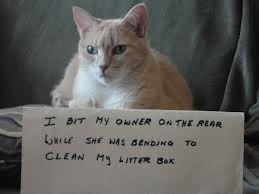Cats need and love to stretch their bodies and paws by scratching. This helps keep their joints limber and wear down the claws. They will often have a good stretch-and- scratch session after a long nap. But how can you protect your home from becoming a shredded mess?
- 1) Keep kitty’s claws trimmed. Get a good pair of claw clippers, I prefer the scissor style as the easiest to use. Trim off only the tip of the nail. Be careful not to cut the quick. If you do, apply a little stiptic powder or ordinary kitchen flour to help stop the bleeding.

- 2) Provide an acceptable scratching item. Is your cat a vertical scratcher, leaning on upright items? Try a tall scratching post or mount a cardboard scratcher firmly on the wall. For horizontal scratchers, items that lie on the floor are best – cork, cardboard, a piece of upside down carpet, or even a log with tree bark on it. Anything they can really get a grip on will work. Make sure the item is firmly fixed so it doesn’t slide around. Put this item near a favorite napping spot since this is prime scratching time!
- 3) Stack the deck by applying a little catnip on the scratcher if your kitty is partial to it. Try dragging their favorite toy over the scratcher to encourage them to dig in. This makes a great daily play session, as well.
- 4) Put aluminum foil sheets on the corners of your furniture. Cats don’t like the metal against their claws and will avoid it. Do NOT use foil with food residue since they may try to eat it! After a few days try removing the foil and see if they return to the item.
- 5) Some kitties like to scratch on audio speakers because they are sturdy and the fabric tears nicely. Try applying packing tape with the sticky side out. Fold over 3-4 inches on each end and stick it to the item. Kitties hate sticky paws. Don’t use duct tape as the adhesive will be hard to remove.
- 6) Consider a motion-sensor air sprayer, available online and at many local pet supply stores. These run on batteries and emit a loud hiss of air if kitty gets near a forbidden item. Highly effective and harmless. Tip: these also are great for training them not to walk on kitchen counters.
- 7) The good old spray bottle filled with water works beautifully. Set it on “stream” and give kitty a spritz JUST as she reaches up to scratch. Don’t yell, let her associate the act with the spray, and not with your voice. I’ve become an expert at the spray-over-my-shoulder technique when they think I’m not looking!
- 8) If you catch kitty in the act of scratching an unacceptable item, clap your hands loudly to interrupt them, then direct their attention to the acceptable item.
- 9) Kittens are enthusiastic scratchers and their claws grow amazingly fast. Keep them trimmed regularly and confine kittens to one room until they have learned which items are acceptable to scratch. Don’t be surprised when they experiment on different items to test “scratchability”. It’s your job to be vigilant and watch them carefully as they explore.
mounds of BMD bm’s I check on our precious darling on the deck. I reach for her leash to take her out again; but now it’s in three pieces, rendering it completely useless. I guess she told me.
I used to believe that cats had a reputation for being a bit more subtle than dogs in their communications with us humans. But, after reading this article:
I’ve come to realize that cats are indeed a bit shout-y in their declarations of love–if you know what to look for.
I have a wonderful friend who writes a lovely blog, A Faded Ginger. One of her recent posts concerned dogs, which of course, caught my interest. Click the link below to read it and let us know what you think.




















